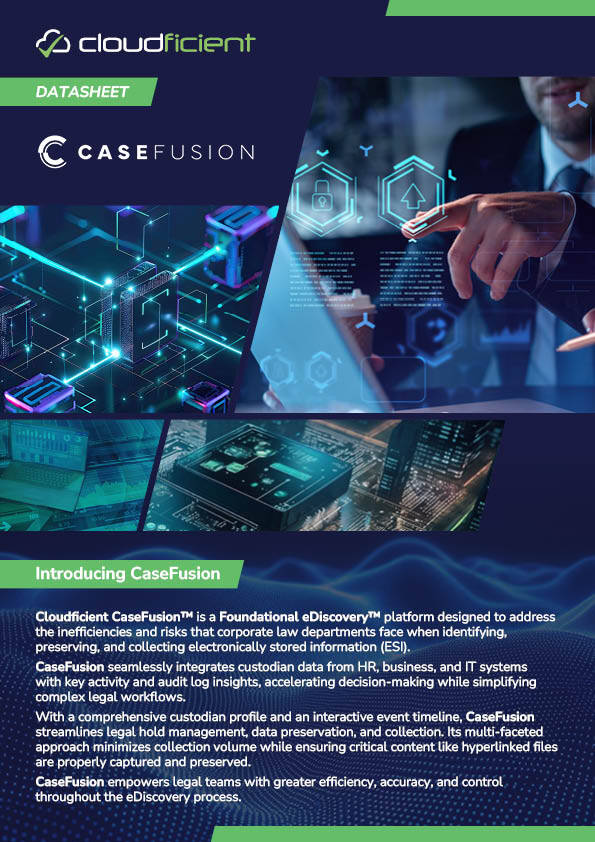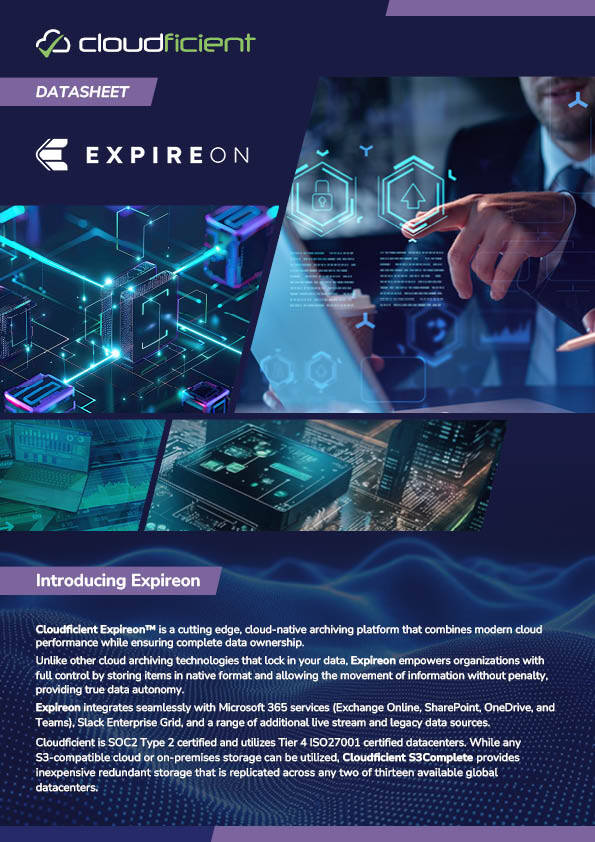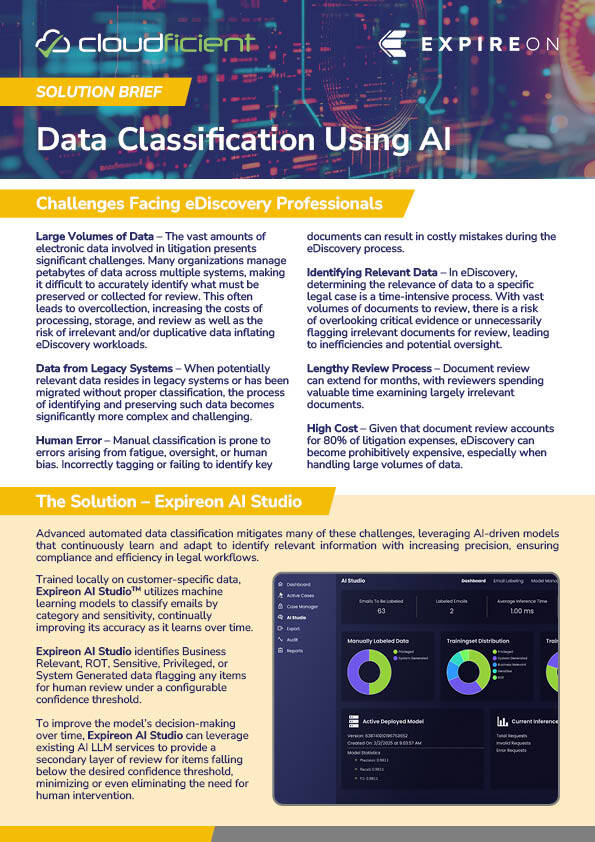- Solutions
- Information Governance
- Data Retention & Compliance
Data Retention & Legal Compliance for Enterprise Organizations
Enterprise organizations struggle with fragmented data retention policies that fail to address the complexity of regulatory compliance across distributed cloud services & technology environments. Traditional approaches to legal compliance have repeatedly exposed organizations to devastating regulatory violations while failing to preserve critical evidence relationships, hyperlinked documents, and AI-classified content. Microsoft 365, legacy systems, and cloud platforms require intelligent data retention best practices and automated policy enforcement that enhance the built-in features of Microsoft Purview.
Challenges in Data Retention & Legal Compliance
The transition from on-premise to cloud has created a fragmented technology landscape in most IT organizations, that makes managing data retention and achieving regulatory compliance across enterprise environments is therefore more complex than ever. Traditional approaches to data retention policy enforcement often break down under the scale and sophistication of enterprise information governance challenges, while organizations struggle with interconnected data relationships and modern data classification requirements.
Data Retention Complexity Across Disparate Systems
Enterprise organizations typically manage data across Microsoft 365, legacy archives, systems inherited from acquired companies , SaaS applications, and cloud platforms, none of which offer unified data retention capabilities or preserve critical data relationships. This fragmentation creates significant challenges for implementing comprehensive data retention polices including:
-
-
Platform-specific retention limitations: Each system requires different retention procedures, leading to inconsistent policy enforcement and gaps in regulatory compliance oversight that only become apparent during eDiscovery and audit processes.
-
Hyperlinked document preservation gaps: Data relationships between systems, and hyperlinked documents referenced in emails and chats are usually ignored during retention operations, resulting in incomplete policy coverage that threatens legal defensibility.
-
Legal system difficulties: Outdated applications and legacy file servers contain crucial business information but lack the modern retention capabilities necessary for policy enforcement and intelligent data classification.
-
Interconnected systems across the cloud: SaaS applications often have gaps in data retention functionality that only surface during regulatory audits or litigation discovery.
-
These challenges force legal and compliance teams to work with incomplete retention coverage, increasing the risk of regulatory violations and compromising defensible information governance.


Microsoft 365 Native Limitations and Missing Evidence Risks
While Microsoft Purview provides data retention capabilities, it struggles to meet modern enterprise legal compliance requirements. Many organizations discover critical
limitations of Purview that undermine comprehensive information governance and create risks of missing critical evidence including:
-
Limited cross-platform coverage: Microsoft365 is not well-suited to retain Slack, Zoom, legacy archives, or acquired company data, creating compliance blind spots when hyperlinks are involved.
-
Hyperlink preservation failures: Standard retention does not preserve referenced documents at the time they were accessed, leading to evidence gaps when hyperlinked materials are deleted according to different retention policies.
-
Weak audit capabilities: Inadequate automated classification makes it difficult to identify sensitive data, PII, and business-critical content, requiring specific treatment under various regulations.
-
Manual process dependencies and late discovery risks: Critical retention decisions often rely on spreadsheets and manual workflows, introducing human error and compliance risks while missing interconnected data relationships that only surface during eDiscovery review.
Organizations relying solely on native Microsoft 365 capabilities find themselves unnecessarily exposed to significant regulatory risks and potential evidence spoliation.
Performing Regulatory Compliance at Scale without AI- Powered Classification
Enterprise organizations manage massive data volumes across complex global regulatory landscapes. This content needs to be classified and categorized for appropriate retention and discovery. Regulatory requirements vary significantly by jurisdiction, industry, and data type, creating operational challenges that can only be solved with intelligent automation like:
-
Multi-jurisdictional complexity: Global organizations must comply with GDPR, CCPA, SOX, HIPAA, and industry-specific regulations, each with different data retention requirements for various types of content.
-
ROT data identification: Redundant, obsolete, and trivial information consumes storage resources and complicates data retention without adding business value. AI-powered classification can automatically identify and appropriately manage this content.
-
Dynamic content classification: Content relationships in modern collaboration platforms change over time. With AI-driven classification those relationships will be continuously updated to ensure proper retention management.
-
Cross-border data challenges: International data transfers and storage requirements complicate retention policy implementation and enforcement across enterprise environments. Understanding sensitive data is a must.
Without intelligent automation and Ai-powered classification, organizations cannot scale their compliance efforts effectively while maintaining defensible retention practices.

Automated Policy Enforcement and Early Case Assessment
Manual data retention processes place an enormous burden on legal and IT teams. Without automation and early case assessment
capabilities, implementing consistent policy enforcement across entire information ecosystems is challenging, and risks:
-
Inconsistent data and missing evidence: Manual retention decisions lead to uneven policy enforcement that creates compliance gaps and legal exposure during audits.
-
Resource-intensive operations: Skilled professionals spend countless hours on repetitive tasks instead of focusing on strategic compliance initiatives.
-
Late discovery of evidence gaps: The traditional approach only identifies missing hyperlinked documents and evidence relationships during review, when supplemental collection requests are often too late or cost-prohibitive.
-
AI classification opportunities: Without automated content categorization, organizations miss opportunities to reduce review volumes and costs, early in eDiscovery.
Organizations that fail to automate their retention processes and ECA capabilities will struggle to maintain regulatory compliance while suffering from low operational efficiency and high litigation costs.
Hold Management and Preservation
Data retention policies need to seamlessly integrate with legal hold requirements to ensure proper preservation during litigation. This coordination creates complex operational challenges like:
-
Conflicts between retention and preservation: Automated deletion often conflicts with litigation hold requirements, potentially destroying evidence necessary for litigation defense.
-
Hold scope complexity: Determining which data retention policies need to be suspended to accommodate legal holds requires a sophisticated understanding of custodian relationships and data dependencies across multiple platforms.
-
Release coordination: Resuming normal retention schedules after holds are released demands careful validation to prevent premature deletion of relevant material.
-
Early identification requirements: Data spread across multiple systems may have different retention characteristics and preservation capabilities.
Without integrated legal hold and retention management, organizations face significant risks of inadvertent spoliation and compliance violations.

Data Discovery, Classification, and Early Evidence Assessment for Retention
Effective data retention requires comprehensive understanding of information types, business relevance, regulatory requirements, and evidence relationships. Modern AI-powered data classification and Foundational eDiscovery will address these challenges:
-
Content identification: Most organizations struggle to automatically identify sensitive data, personally identifiable, and business-critical information that require specific retention.
-
ROT data proliferation: Redundant, obsolete, and trivial information consumes storage resources and complicates retention policy implementation without adding any business value.
-
Dynamic content classification: Modern collaboration platforms create content relationships that change over time, requiring consistent classification updates to ensure proper retention management.
-
Cross-system data mapping: Understanding data flows and dependencies across multiple platforms is essential for creating coherent retention policies.
Without intelligent data discovery and classification capabilities, implementing targeted retention policies to balance compliance requirements against operational efficiency is almost impossible.
Legal Compliance & Data Retention Best Practices
Effective data retention and regulatory compliance requires a strategic approach combining AI-powered classification, automated enforcement, policy framework creation, and comprehensive governance oversight. These best practices ensure legal defensibility while optimizing operational efficiency across complex environments.
Implement AI-Powered Data Classification
Machine learning systems can automatically categorize information by business relevance, sensitivity, and retention requirements across M365, legacy systems, and cloud applications. Establish multi-jurisdictional retention policies that leverage intelligent classification to reduce legal exposure and eDiscovery data volumes.
Automate Retention with Hyperlinked Evidence Preservation
Implement intelligent automation that enforces retention policies while capturing and preserving referenced documents, embedded files, and hyperlinked materials at the time they are accessed across all platforms. This ensures that linked content from Microsoft 365, Slack, legacy systems, and cloud applications remains accessible in its original state complete with metadata, timestamps, and preserved context. Automated workflows eliminate manual preservation gaps, prevent evidence spoliation, and maintain legally defensible chain of custody while aligning retention rules across enterprise systems.
Centralize Information Governance with Cross-Platform Visibility
Establish unified governance structures that provide real-time oversight of retention activities, compliance status, and policy enforcement across enterprise systems including legacy archives and SaaS applications. Deploy comprehensive monitoring that tracks hyperlinked content relationships and policy effectiveness across all platforms. Centralized governance ensures consistency while reducing complexity and maintaining defensible retention practices.
Deploy Proactive Hold and Case Assessment Workflows
Integrate legal hold management with retention systems to ensure seamless preservation while implementing assessment capabilities that identify evidence before review begins. Automated systems intelligently suspend conflicting deletions while maintaining business-critical retention schedules and preventing spoliation. Proactive workflows optimize operational efficiency while maintaining defensible audit trails.
Establish Intelligent ROT Data Management
Utilize machine learning that continuously improves classification accuracy, automatically separating business relevant content from ROT data while flagging uncertain items for review. Deploy systems that streamline eDiscovery workflows by recognizing relevant content and handling sensitive information according to regulatory requirements. Organizations with intelligent classification enable targeted policies while reducing review volumes and operational costs.
Create Cross-Platform Preservation Capabilities
Develop unified preservation strategies that handle data scattered across multiple enterprise systems while maintaining complete evidence relationships and data integrity. Implement unified data management workflows across Microsoft 365, legacy archives, cloud applications, and acquired infrastructure that automatically preserve referenced materials and identify evidence gaps before expensive review. Cross-platform capabilities ensure complete compliance coverage and regulatory adherence.
Our Solutions
Cloudficient addresses the complex challenge of addressing data retention and regulatory compliance across fragmented enterprise environments. We deliver automated, defensible solutions that preserve evidence relationships while ensuring comprehensive policy enforcement and AI classification at enterprise scale.
Expireon - A cloud-native archiving platform based on the customer's full complete data autonomy & sovereignty. It seamlessly integrates with Microsoft 365, Slack, legacy archives, and provides a new home for data from acquired companies. Expireon provides automated hyperlinked document preservation, capturing referenced materials at the time when they were originally sent or accessed. Ensuring the preservation of evidence relationships is a new benchmark for regulatory compliance and eDiscovery readiness.
Expireon AI Studio - Our AI-powered classification engine. It learns from your data to automatically categorize content by business relevance, sensitivity, and retention requirements. AI Studio continuously improves at identifying business relevant, ROT, sensitive, privileged, and system-generated data. It reduces review volumes by up to 33% and enables targeted data retention policies.
Hyperlize - The first production analysis platform that identifies missing evidence by analyzing load files to detect deficiencies such as referenced hyperlinked documents that weren’t produced. Using Hyperlize enables you to make immediate supplemental collection requests that prevent regulatory compliance violations and litigation exposure.
CaseFusion - Foundational eDiscovery platform that unifies custodian identification, legal hold management, and evidence preservation workflows across HR, IT, and business systems. Streamline data retention policy enforcement through integrated workflows that coordinate hold requirements while maintaining defensible audit trails across complex enterprise environments.
Frequently Asked Questions
What is data retention?
Data retention is the systematic practice of preserving electronic information for specified periods to meet legal, regulatory, and business requirements across enterprise environments. It encompasses automated policy enforcement, intelligent content classification, and coordinated preservation workflows that manage information lifecycle from creation through defensible disposal while maintaining evidence relationships and hyperlinked document integrity.
What is a data retention policy?
A data retention policy is a comprehensive framework that defines how long different types of electronic information must be preserved, when it can be disposed of, and under what circumstances preservation requirements change during legal holds or regulatory investigations. Effective policies integrate AI-powered classification, cross-platform preservation capabilities, and automated enforcement mechanisms to ensure consistent compliance across Microsoft 365, legacy systems, and cloud applications.
What is the data retention policy?
The data retention policy refers to an organization’s specific documented framework governing information lifecycle management, regulatory compliance obligations, and evidence preservation requirements. It establishes standardized retention schedules, automated disposal processes, legal hold procedures, and cross-system governance structures that balance operational efficiency with defensible information management practices across complex enterprise environments.
What is regulatory compliance?
Regulatory compliance is the process of adhering to laws, regulations, and industry standards that govern how organizations collect, process, store, and dispose of electronic information. It requires implementing comprehensive data retention policies, automated classification systems, and defensible preservation workflows that address multi-jurisdictional requirements including GDPR, CCPA, SOX, HIPPA, and industry-specific mandates while maintaining audit trails and evidence integrity.
What is a regulatory compliance framework?
A regulatory compliance framework is an integrated approach to meeting legal and industry obligations through systematic data retention policies, automated enforcement mechanisms, and comprehensive governance oversight. It combines AI-powered content classification, cross-platform preservation capabilities, early case assessment tools, and proactive monitoring systems to ensure consistent adherence to evolving regulatory requirements while reducing operational complexity and litigation risks across enterprise environments.
.png?width=620&height=82&name=Untitled%20design%20(18).png)
.png?width=600&height=79&name=Untitled%20design%20(18).png)
-3.png?width=250&height=33&name=Untitled%20design%20(18)-3.png)






